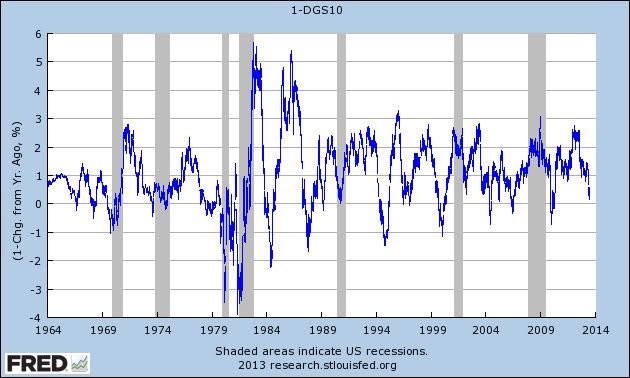- by New Deal democrat
At this point probably everybody who pays attention knows that interest rates have backed up a full 1% in the last month. That it will have a strong negative impact on mortgage refinancing and some negative impact on the purchase of houses also has been widely remarked.
But is it enough to bring on a recession? No, or at least, not yet.
As it turns out, while recessions in the last 50 years have always been preceded by a 1% YoY increase in interest rates, a backup in interest rates is not a sufficient signal by itself to forecast a recession. I've shown this in the below graph of 10 year treasuries. The values are inversted so an increase shows up as a decrease. I've also added 1 to the values, so that a +1% increase in interest rates shows up exactly at zero:

Interest rates have backed up at least 1% YoY 15 times in the last 50 years. In 7 of those cases, a recession has folloed within the next 2 years. So the increase in rates is a necessary but not sufficient marker of recession.
What has made a difference is the duration of the increase, at least since the beginning of the great decline in interest rates over 30 years ago. Below is a graph that I posted a little over one year ago, showing conventional mortgage rates since their peak in 1980. The red sections represent those periods of time where mortgage rates have failed to make a new low for at least 3 years:

As you can see, all three of the recessions since 1982 have been immediately preceded by a 3 year or longer period where interest rates failed to make new lows.
Interest rates on mortgages made new lows about 1 year ago. So while the rise in interest rates is a definite concern, it hasn't lasted long enough to trigger a warning of a new recession. We'd need to see the increased rates continue for another year or even two before a recession would likely occur.